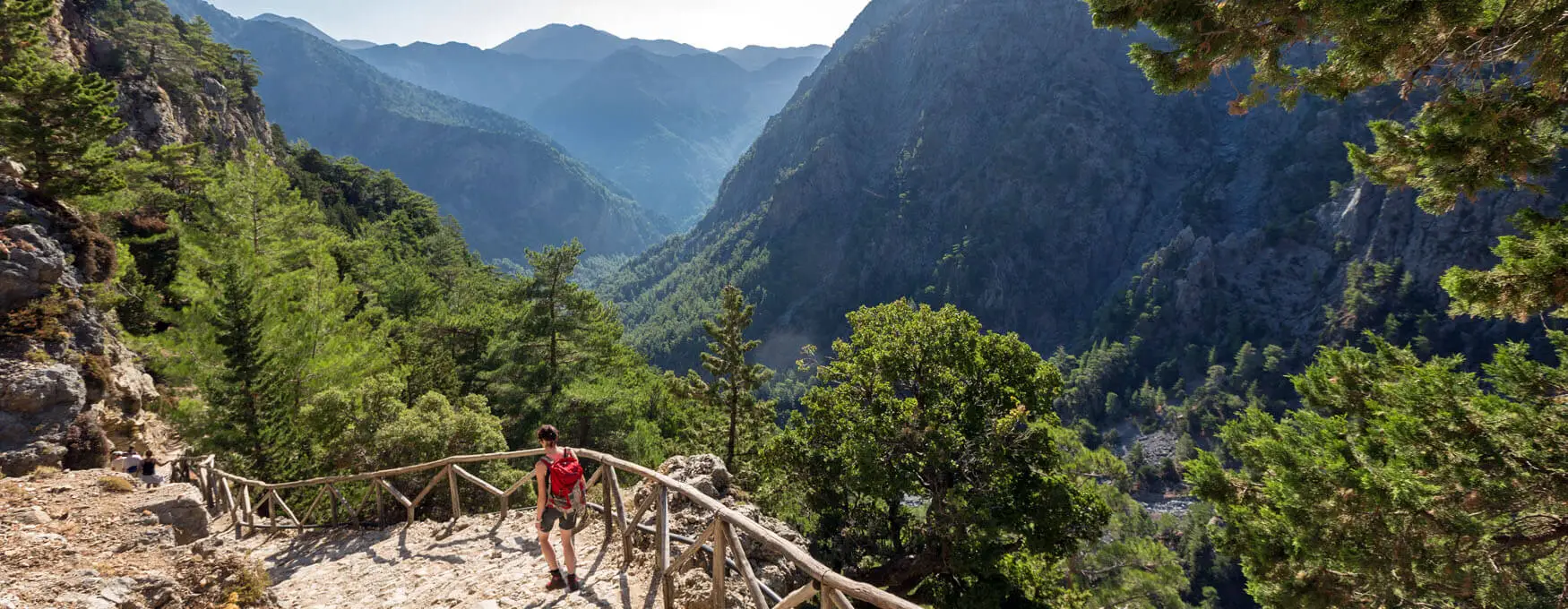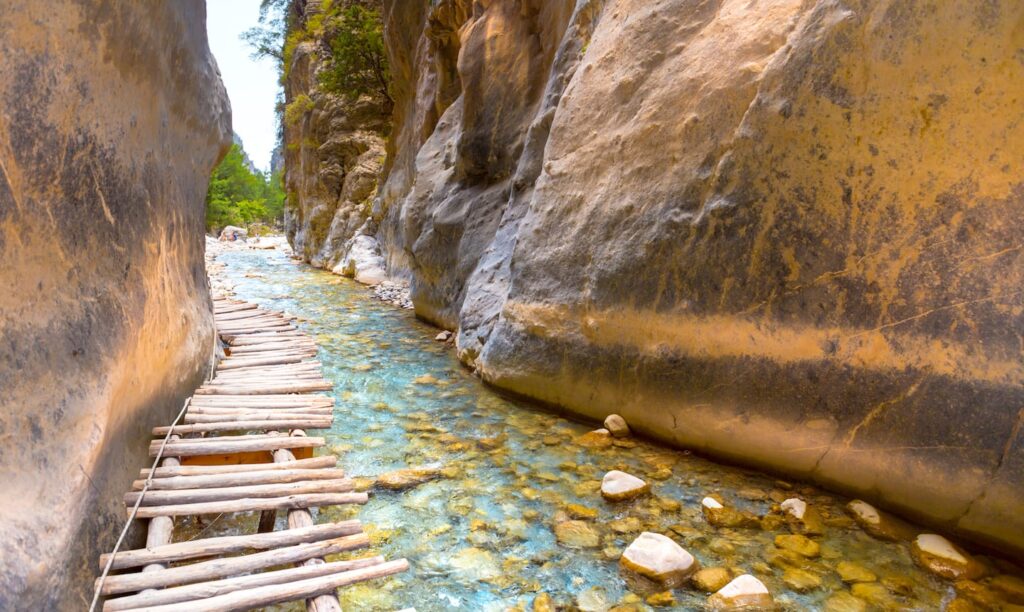
Crete gazes at the Mediterranean Sea. Do the same!
White Mountains’ National Park is the only national park in Crete. It centres around the Samaria gorge, at an altitude of 1,200m and continues down to Agia Roumeli, on the shores of the Mediterranean Sea. Along with the surrounding slopes and a number of smaller gorges branching off from it, Samaria Gorge forms the whole of the area designated as a national park, a status that offers protection to over 450 species of plant and animal, 70 of which are endemic to Crete. In the prefecture of Chania (also written “Hania”), the Samaria gorge is the longest in Europe (total length 16km), and one of the most impressive gorges in Greece. It starts from Xyloskalo, at an altitude of 1,230m. The width of the gorge is 150m at its widest point and 3m at its narrowest.

Useful Information
It is recommended that the entrance to the Gorge from Xyloscalo should be done as early as possible.
The crossing must be done slowly, with many stops and following the instructions of informational placards and rangers.
The visitors must have appropriate clothing, footwear and sun protection (hat, sunscreen).
You must have with you something to eat, since there are no shops inside the Gorge of Samaria.
You must have water with you, but since there are several springs inside the Gorge you can refill your bottle.
There are toilets in several places along the path.
You must dispose your litter only in the waste bins that you will find along your way.
Here is a brief hiking map:
As you walk downhill, you will come across the church of St. Nikolas, built on the ruins of an ancient temple. Half way down the gorge lies the old village of Samaria; its few houses are now used by the park wardens. Quench your thirst with mountain water running from the gorge’s springs. Keep walking. At some point you will reach Portes (also called “Iron Gates”), the three narrowest passages of the gorge. The steep cliffs here tower as high as 500m above sea level. This route also goes past Venetian castles and ruins of prehistoric settlements as well as remnants of many other historical periods. As you are walking, you might feel as if someone else is watching you: the presence of the wild Cretan goats, known as “kri kri”, will definitely make this route particularly exciting!
The hike ends at Agia Rouméli, where you can catch the ferry to Chora Sfakion.
Agia Roumeli
Agia Roumeli is a small coastal village that you reach after walking through the Samaria Gorge. From here a frequent boat service will take you directly to Loutro and Hora Sfakion. The ancient Greek site of Tara, is on the left (east) hill as you exit the gorge. Many of the finds from Tara are housed in the Archaeological Museum of Chania. Tara flourished during Greek, Roman and Byzantine times. In Agia Roumeli you can also visit the Byzantine churches of Panagia, Agia Triada, and Agios Pavlos, a Turkish castle and an exceptionally beautiful beach.
Nearby beaches: To the east of Agia Roumeli discover the beaches of Marmara (at the exit of the Aradaina gorge), the wild beaches of Lykos and Finikas, and the charming village of Loutro.
Loutro
You can make a short or even a longer stop here on your way back to the point where your hiking adventure in the Samaria gorge began. The village can be reached by boat from Hóra Sfakion and Ayia Rouméli or on foot from Anopolis, Hora Sfakion, and Agia Roumeli. (Hiking tip: The footpaths appear deceptively short, especially in the heat of the summer. In addition, they may also be dangerous for inexperienced hikers. If you are not a hiking expert, take the boat from Hóra Sfakion; the trip lasts about 20 minutes.)
What can you do here?
- Well, first of all, you can just enjoy the laid-back atmosphere of the place.
- If you feel bored, daily boats will take you to the beaches of “Sweetwater” (where fresh water pours into the sea) and “Mármara”.
- There are footpaths leading to “Pervolakia” and “Timios Stavros” beaches, and a rather strenuous hike will take you to the beautiful village of Anopoli, high on the cliff overlooking the Mediterranean Sea.
- Rent a boat to explore the area around Loutro.
- Dive to explore the crystal-clear waters and the amazing seabed of the Mediterranean Sea.
- Take a boat and go on a day trip to the island of Gavdos, the most southern tip of Europe—the dolphins will show you the way.
- Embark on a sailing adventure to discover inaccessible beaches—you might find a completely deserted one you can have all to yourself!
Getting there
There are excursions to the Samaria gorge from the most cities and resorts on the island. You can even trek through the gorge under your own steam. Choose the city of Chania as your base. From here buses will take you to Xyloskalo. You can reach Agia Roumeli on foot (at the exit of the Samaria gorge); there are several footpaths leading there. Frequent boat services (4 to 5 times a day) from Chora Sfakion will also take you to Agia Roumeli and Loutro. This small fishing village can also be reached on foot from Anopoli, Sfakia or Agia Roumeli.